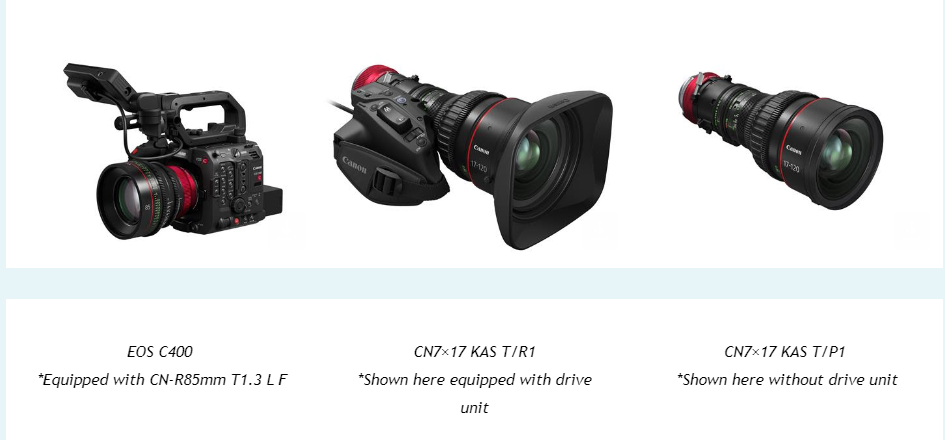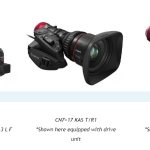.png)
Canon has announced two major releases: the EOS C400 digital cinema camera, a new product in the CINEMA EOS SYSTEM series of video production equipment, and the CN7×17 KAS T/R1 and CN7×17 KAS T/P1, which are additions to the EF/RF Cinema Lens series lineup named “CINE-SERVO Lens”1.
The EOS C400 will launch in early September 2024 and combines high mobility with an enhanced set of interfaces, enabling high-quality visual expressions during broadcasts and live video production. The camera features an RF mount, while inheriting the basic functions of EOS C500 Mark II (released in December 2019) and EOS C300 Mark III (June 2020) in further refined forms.
It comes equipped with a 6K full-frame sensor capable of producing high-quality footage with a shallow depth of field and gorgeous bokeh. Its compact and lightweight design, coupled with an extensive set of interfaces, makes it suitable for cinematic visual expressions in both movie and live video production settings.
This marks the first time that an RF mount has been used in a high-end CINEMA EOS SYSTEM product, allowing for enhanced communication functions such as lateral chromatic aberration corrections, light intensity corrections, dual pixel focus guide display, and distortion corrections. The high-speed communication capabilities of the RF mount enable metadata output required for virtual production. Additionally, the camera supports the use of PL lenses with the newly released Mount Adapter PL-RF and EF lenses via a separately-sold mount adapter2.
For the first time in the CINEMA EOS SYSTEM, the camera is installed with a 6K full-frame back-illuminated, stacked CMOS sensor. It also includes DIGIC DV 7 as its image processing engine which enables recording at high frame rates of 6K/ 60P RAW video and 4K/120P3. The EOS C400 also reproduces natural tones from low to high brightness, reduces noise in dark areas, and improves 4K image quality through 6K oversampling. It is even equipped with Dual Pixel CMOS AF II and therefore capable of rapid, highly accurate and wide-ranging AF with excellent trackability.
The camera’s small, lightweight housing includes various interfaces such as GENLOCK/SYNC/RETURN and ETHERNET terminals. Functions necessary for live video production, like the tally function and return function, are integrated without the need for an expansion unit. The new proprietary video format XF-HEVC S/XF-AVC S supports metadata and improves workflow efficiency by allowing easier file management at filming locations.
Meanwhile, Canon’s CN7×17 KAS T/R1 and CN7×17 KAS T/P1 CINE-SERVO lenses will be available in early October 2024. CN7×17 KAS T/R1 has an RF mount, a first in the CINE-SERVO Lens series, while CN7×17 KAS T/P1 has a PL mount which is widely used in the visual industry. Both cinema lenses inherit features from the conventional model CN7x17 KAS S (released in August 2014) such as high optics for 4K/8K support, while offering new features including enhanced communication functions and improved operability and functionality through the inclusion of the new digital drive unit e-Xs V. CINE-SERVO lenses meet a broad range of needs of expanding shooting methods from live sports broadcasts to remote shooting and virtual production for movies and other video productions, and demand for efficient workflows.
In compliance with RF mount communications protocol, the lenses can be combined4 with EOS C400, EOS C70 (released in November 2020), or EOS R5 C (March 2022) cameras to make lateral chromatic aberration corrections and light intensity corrections and adjust the dual pixel focus guide through camera operation just like previous models, in addition to supporting distortion correction as a newly added feature. The lenses also support metadata output for virtual production, enabling highly accurate CG compositing in real time and post-production.
For the first time in the CINE-SERVO series, the lenses will come equipped with the new e-Xs V digital drive unit. The focus and iris are faster than previous models, allowing camera operators to shoot just as intended even when capturing rapidly moving subjects such as during sports broadcasts. The optical design limits changes in the angle of view that occur during focusing, while the lens features a focus breathing correction function linked with the zoom function to automatically make precise corrections. Additionally, the highly versatile USB Type-C terminal makes it possible to export and import lens setting data and update firmware on their own.
The new lenses offer broadcast-style operation through servo control and cinema-style shooting focused on manual operation. They also feature 12-pin serial communication, a standard for broadcast camera systems, and support /i Technology from Cooke Optics and eXtended Data5 from ZEISS. This external output of lens-related information in real-time improves the efficiency of shooting and editing.
To find out more about Canon’s products, visit: my.canon/en/consumer/products.






